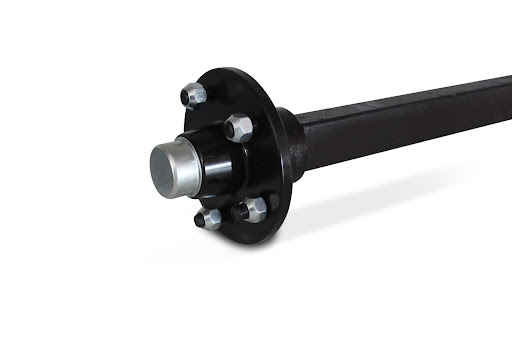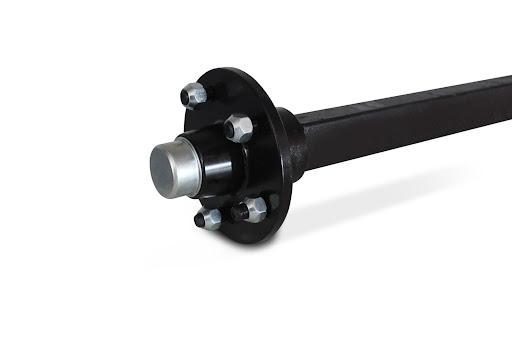What is a lazy axle?
Trailer axles come in many designs and shapes to suit the trailer’s purpose. In the simplest of terms, an axle supports the entire weight of the trailer and load transferring the load through to the wheels. The wheels are bolted to the lazy hubs which move freely on bearings. As simple as axles sound, they are integral to every trailer.
Trailer axles play a role in deck height, tow height, along with the suspension and wheel type. The axle also allows a fully loaded trailer to function correctly. Axle types include lazy axles, mechanical disc axles, and electric brake axles. It is important to get the best trailer axles, hubs, and parts at a reputable trailer parts shop like Trailer 2000 Parts. However, if you are new to trailers, it might be difficult to know which is best for your trailer. So what is a lazy axle, and which is best for your trailer? Read on to find out.
What is a lazy axle?
A lazy axle is an axle type on a trailer without brakes. Also known as a dead axle, lazy axles are free-rotating and only roll along when the tow vehicle begins to move. Trailers with a GVM of 750kg use lazy axles. Unlike other axles with brakes, a lazy axle trailer can not be brought to a controlled stop as it is non-driven and has no brakes.
Some examples of lazy axles from our trailer parts shop include:
1.25T 45 SQ. LAZY AXLE FORD – 2120MM F/F

The 1.25T 45mm SQ. LAZY AXLE FORD has a 2120MM hub face distance and is compatible with 1800mm-wide chassis using wheels with a 110mm backspace.
1.6T LAZY AXLE 6 STUD P/B – 1520mm F/F

The 1.6T LAZY AXLE 6 STUD has a 1520mmhub face distance and suits 1200mm-wide chassis using wheels with a 120mm backspace.
How do lazy axles compare to other trailer axles?
Besides lazy trailer axles, the other types of trailer axles include mechanical disc axles, and electric brake axles. Let’s look at how each operates in comparison to lazy axles.
Lazy axles vs. brake axles
Unlike a trailer with a lazy axle, a trailer with brake axles has a braking system that could be mechanical or electric. With the electric braking system, a driver can apply brakes to the trailer and bring it to a controlled stop. Mechanical brakes activate when the vehicle stops by the force applied from the trailer pushing up against the trailer, this then activates the mechanical coupling on the trailer which applies the brakes.
Brake axles, such as electric brake axles, are activated when the driver applies the brakes. The brake controller either on the trailer or within the vehicle is then powered by the brake lights which then applies the trailer brakes. The force with which the brakes are applied can be adjusted on the brake controller.
On the other hand, trailers without brakes rely entirely on the towing vehicle to provide control, especially in emergency situations. Under certain circumstances, a trailer with brake axles can engage the brakes, providing increased control of the trailer.
Trailers up to 2000Kg GVM are generally fitted with more than one axle and generally have the lazy axle at the rear and the braked axle as the front axle. This is because, on a loaded trailer, the majority of the weight rests on the forward-most axle. If the brake axle is fitted in the rear, the brakes may be less effective, especially in emergency situations. However, trailers above 2000Kg GVM have brakes on all axles and these trailers are fitted with Electric brakes, a safety breakaway system and are controlled from within the vehicle.
How to select the best axle for your trailer
You might think of just stopping by any trailer parts shop to pick an axle for your trailer, but there are certain factors to consider before making that order. Every trailer axle is built to perform the same role. However, the axle types have different purposes and are tailored to certain user requirements. Let’s look at some major things to consider before picking an axle.
1. Load Capacity
Before picking any axle, you must consider how much weight the axle can carry. Load capacity represents the total weight rating of the trailer, and the load capacity must align with the Gross Vehicle Mass (GVM). Generally, it is best to go for trailer axles with more capacity than you require.
2. Wheel and tyre capacity
Although trailer wheels and tyres are technically not part of the axle, they play a huge role in determining what type of axle you get. It is important to note that the tyre and wheel load capacities should be higher than that of the axle.
Other things to consider before selecting an axle include the following:
- Length
- Width of Chassis
- Axle spacing
- Stud pattern
- Mounting position
- Backspace of Wheel
If you’re still undecided about what axle is best for your trailer, contact us, and our team of professionals can help you make the right decision. At Trailers 2000 Parts, our “click and collect” service allows you to order any trailer part from the online trailer parts shop or collect the item from our head office at 10 Bondi Crescent, Beerwah, Sunshine Coast QLD 4519.
Trailers 2000 Parts is an Australian manufacturer of quality trailers and a retail of trailer parts. From lazy axles and lights to U-bolts and jockey wheels, you can rest assured when you shop our products. Quality, innovation, durability, and excellence are our focus, and distance is no barrier, regardless of your location in Australia. Browse our extensive range of trailer parts and accessories today!
